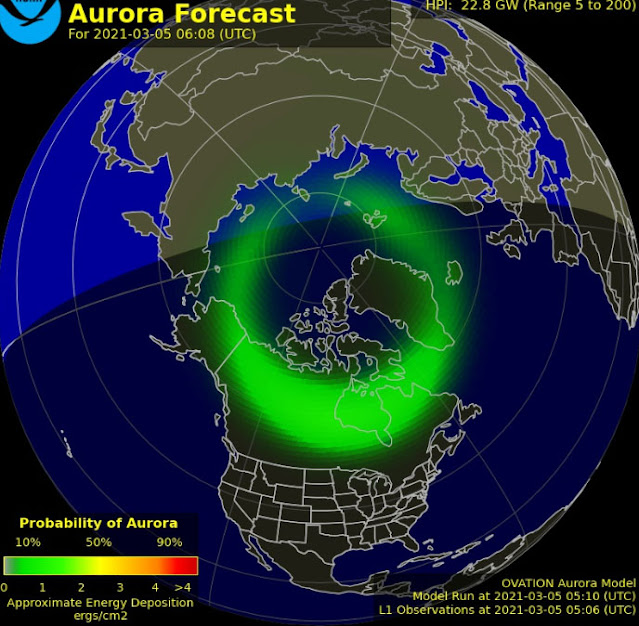Minor Geomagnetic Storm Forecast for Friday Night March 5-6
The latest forecast from the NOAA space weather folks predicts a Kp index of "5" from 6 to 9 p.m. Central Time Friday night, March 5. If you live in the northern U.S. and southern Canada, that number indicates a minor geomagnetic storm. Kp is a measure of how vigorously the Earth's magnetic field is stirred up by high-speed particles arriving from the sun and ranges from 0 to 9. The higher the number the more vivid and extensive the aurora.
On March 2, the Kp index was also 5, and although the aurora remained low and "quiet" during the early evening hours, it broke out into moving rays and bright arcs in the bottom of the northern sky later that night. Generally, the aurora is most active from around midnight to 1 a.m. The forecast is for clear skies tonight, so I'll be out watching with hope in my heart.
To monitor aurora activity, check the most current 3-day forecast and the extent of the crown-like auroral oval perched over the planet's geomagnetic pole, which is currently located under the Arctic Ocean and headed toward Siberia. Yes, it migrates!
When the magnetic field bundled with the solar wind (particle streams from the sun) links into the Earth's magnetic bubble, the oval expands southward into southern Canada, the northern U.S. and can keep on going during severe geomagnetic storms all the way to Arizona and beyond. If you see that the oval fringes the area where you live, find a location with a dark northern sky. Allow your eyes 10 minutes to adapt to the night, and look for a diffuse, rainbow-like arc of light about a fist above the northern horizon.
Next is the hard part. The arc may just sit there, showing little or no activity. You can choose to leave at this point, but I suggest that you stick around for the next half-hour to gauge which way things are going. If the arc brightens, thickens or doubles, stay longer. Those are all signs of an intensifying aurora that could evolve into moving rays and pulsations guaranteed to rob you of sleep. If instead the arc slowly fades until it's barely visible, chances are the show is over. Just remember. When you turn back home and get ready for bed, look out the window one last time... just in case.






Comments
Post a Comment